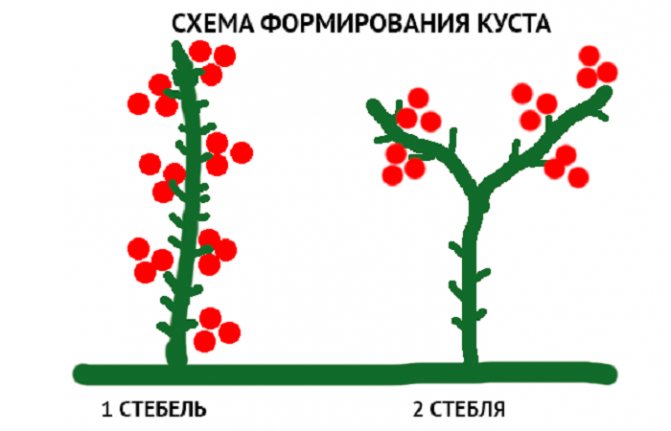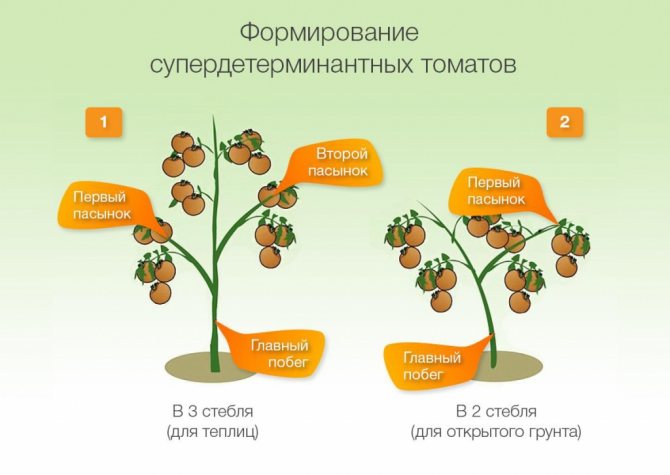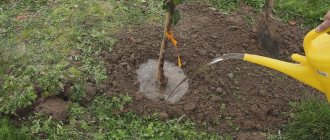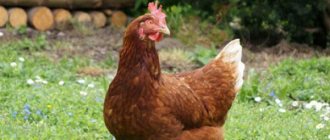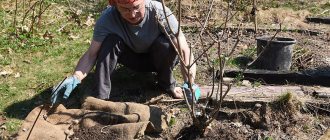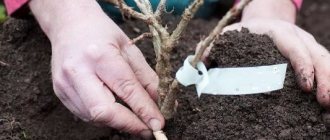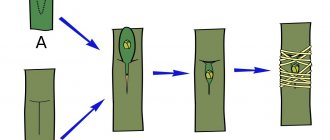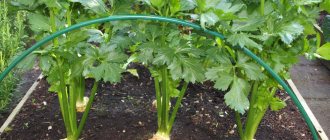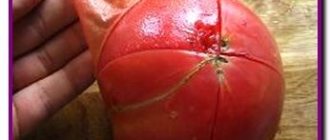Author rating
The author of the article
Yakov Pavlovich
Professor, Head of the Department of Vegetable Growing
Articles written
153
Tomatoes are loved and used in food by all people, they are used both fresh and canned. Therefore, gardeners are trying to get the maximum yield. To achieve this, you need to grow not a huge green bush, but more tasty fruits. Therefore, to remove excess greenery, tomatoes are pinched at a certain time in the open field or in a greenhouse, according to several different schemes.
Why stepchildren tomatoes
Stepsons are shoots that form on the sides of the tomato stem. They emerge from the axils above the petioles of the leaf blades and use nutrients in the same way as inflorescences and clusters with growing fruits. At the same time, they receive food at the expense of the developing crop. Removing excess shoots is called pinching. By correctly cutting off the shoots, you help the bush to direct its forces to the formation and growth of the crop. Removing excess shoots increases the total yield in a certain area, makes it possible to grow an earlier harvest.
Almost any variety of tomatoes needs pinching. Only standard varieties - a type of determinant tomatoes - can do without it. They are also called tomatoes for the lazy. For them, it is not necessary to carry out pinching, they are not tied up and do not form a plant. Bushes grow low no higher than 50 cm with a thick and strong stem. Such varieties are formed no more than 3-5 fruiting brushes, after which the growth stops. They are often grown in the open field; they give the maximum yield in the warm regions of the country, where they ripen in the open air.
What is tomato pinching
Passionate is a procedure for the artificial removal of lateral processes (stepchildren) that form in the leaf axils. The need for this procedure arises for several reasons.
Important! If you do not trim the shoots at the right time, then the fruits that have already appeared on the bush will ripen very slowly, and the newly formed ones will be very small in size.
Cutting off shoots allows you to:
- reduce the load on the plant and thereby accelerate its ripening, this is especially important in the northern regions, where the ripening period of tomatoes is reduced;
- provide fruits with more nutrition and moisture, thereby accelerating their growth and development;
- guarantee high productivity of the bush;
- avoid various diseases, including late blight.
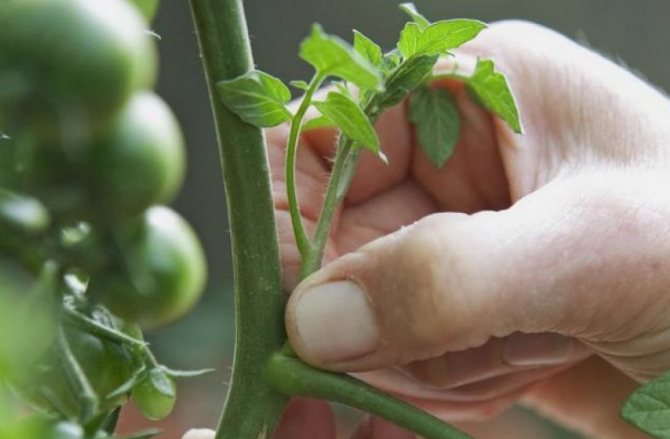
Tomatoes tend to grow strongly. Throughout the entire period of ripening, new shoots, processes, ovaries, flowers grow on the stems. All additional processes significantly reduce the quality of the fruits and their size, as a result, in the absence of pinching, gardeners get a beautiful, green, leafy bush, but with small, sometimes deformed, fruits.
The negative effect of additional shoots on tomato bushes is as follows:
- significant reduction in fruiting;
- reduction in the size of the fruit;
- prolonging the ripening time of tomatoes;
- the formation of abundant foliage of the plant, which contributes to the development of various infections;
- wide growth of the bush, which entails its deformation.
The plant, on which the extra shoots remain, forms a large number of fruits.However, due to a lack of nutrients, they do not have time to ripen during the warm period and acquire the required size. It is worth noting that pinching is not always necessary. Usually, domestic summer residents plant determinate varieties of tomatoes in open soil, in which the growth of the stem is limited.
Learn how to tie tomatoes correctly.
Such plants are distinguished by the fact that when a certain number of ovaries (from 3 to 7) appear on the stem, the lateral shoots stop forming automatically. Thus, pinching is not worth doing, since as many shoots grow on the plant as is necessary for optimal nutrition of the entire bush, including the fruits.
Indeterminate varieties are characterized by unlimited stem growth and the constant formation of additional shoots. In such cases, pinching will positively affect the yield of the plant and the size of the fruit.
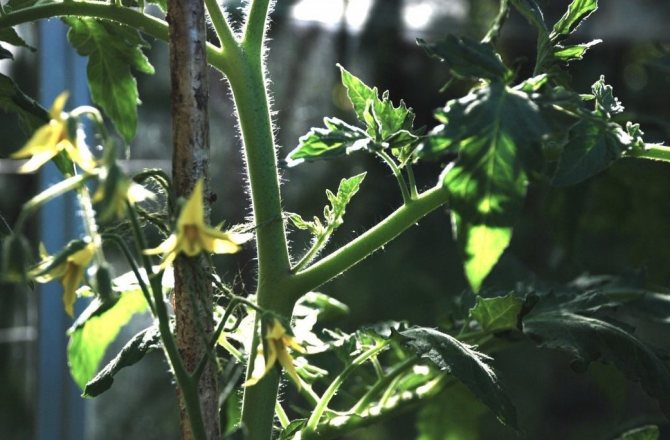

How to properly remove stepchildren in a greenhouse
All gardeners face the problem of a lack of free space in the greenhouse. If you plant tomatoes closely, then the overgrown greens will begin to oppress neighboring plants, pinching will help in this case. You just need to understand the rules for doing the work and learn to distinguish the shoots that need to be removed. Not every novice gardener can distinguish a fruitful shoot from stepsons. An unnecessary shoot appears only in the leaf axil, in the place from which the leaf grows, right above it.
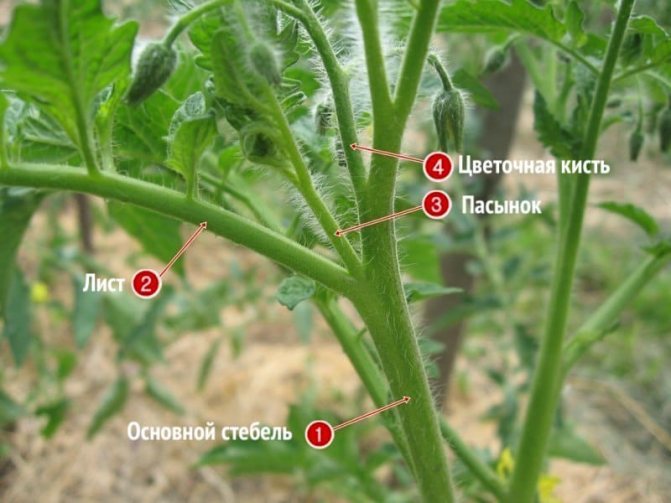

Stepchildren are removed in the greenhouse in almost the same way as in a regular garden bed. Tomatoes tolerate such an operation painlessly if you follow a few rules.
- First you need to decide how best to form the plant - in 1,2 or 3 shoots. In polycarbonate greenhouses, only one shoot is often left on tomatoes, but this depends on the availability of free space and the characteristics of the variety.
- After that, the frequency of removal of stepchildren is planned. Ideally, the work is done once a week, but once every 10 days is acceptable.
- The first time you need to break off the processes only after they become longer than 5 cm - the plant should get stronger.
- The formation of plants is carried out only on warm days, 3 days before that, no feeding and watering is carried out.
- The work is done in the morning, the stepsons break off better at this time or in the evening - the injury will dry well until morning.
- After removing excess shoots, it is advisable to sprinkle the injured areas with wood ash.
- You can remove no more than 3 leaves or shoots at a time.
- Leaving a small stump with a length of 2-3 cm will prevent the appearance of a new stepson.
After finishing pinching, you need to water the tomato bushes abundantly.
It is undesirable to use any tools, because of this, viral diseases can get into the wound. Better to do it with your hands. To do this, the process is taken with two fingers, and pinched at the base. When pinching, you need to leave a small stump 1-2 cm long, this is required so that a new shoot does not begin to grow in this place. Do not break off the sprouts by pulling it down - this can damage the tomato stem.
Expert opinion
Stanislav Pavlovich
Gardener with 17 years of experience and our expert
Ask a Question
Attention! When removing the stepson, try to do the job so that the juice does not stain your hands or gloves. With the juice, the viral infection will be transferred to other bushes.
Timing
The first time the stepsons are cut off after 1 shoot is formed above the first inflorescence. Do not let it grow longer than 5 cm, it draws juices from a young and weak plant. It is more difficult to cut a long stepson without injuring the stem, and unnecessary wounds lead to infection of the bush with diseases.


It is best to go to sleep in the morning, with normal lighting and good ventilation. It is necessary that there is no rain and it is warm, start work with healthy and strong plants. Pinch loose bushes or diseased ones last.You will have to remove stepchildren about once every 7-10 days.
See also the benefits and harms of tomatoes for the human body
Removal rules
Removing excess shoots helps protect plants from fungal infection; fungal spores move between plants under the influence of rain and wind, especially when it is cool. After pruning, the aeration of the tomatoes is improved, which is especially important in a closed greenhouse. After pruning, the larvae of the pests will damage the plant less.
Of course, you cannot pick off many shoots and leaves at once. The green mass, using photosynthesis, produces nutrients, but part of the leaves must be cut off during pinching:
- Remove dry, yellow and old leaf blades. Sick leaves, too, should not be sorry.
- Cut off the leaves that are near the soil, this will help pass the sun's rays to the stem.
- Shaded leaf blades and covering inflorescences and fruits are cut off.
- In the middle tier, dense thickets are cut out to improve lighting and ventilation.
- Don't leave a twig growing directly under the flower brush. It will absorb most of the nutrients, this will reduce the weight of the fruit, and they will grow unsweetened.
- On the day before pinching, the plants are not watered.
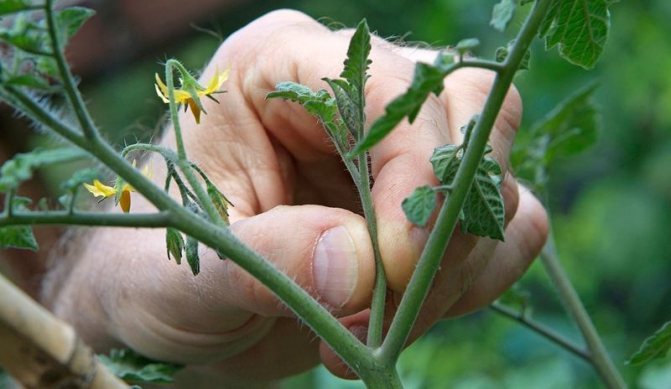

Important! The general rule of thumb when pruning is to remove any appendages below the first inflorescence.
To prevent the spread of diseases, cut stepchildren are removed by placing them in a compost heap.
Basic pinching schemes step by step
There are several schemes for pinching tomatoes, but they have a lot in common, the rules are the same for any method. The shoots are removed, preventing them from growing longer than 3-4 cm, if it is larger, then by cutting off the stepson you will make a long healing wound on the stem.
One stem
When growing tomatoes in a greenhouse, it is better to form them, leaving 1 stem. So you will get unheated plantings, air can move between the plants and each leaf will receive enough light.
To do this, as soon as the first inflorescence opens, a stepson will begin to develop under it. It is immediately cut off, along with the lower leaves, which are no longer needed and only prevent the airing of the tomato bushes from below.
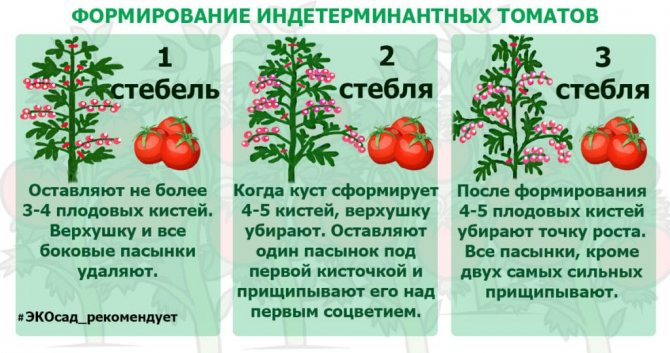

After that, ruthlessly remove any processes in a timely manner, leaving flowering brushes and leaves located above. A bush formed in this way will be able to feed up to 50 high-quality brushes. Also, the formation of a tomato in 1 stem will increase the fruiting time.
Two stems
With this formation, the main stem is first left on the plant, on which a strong lateral shoot is subsequently left. Most often, it appears in the axil of the leaf blade above the first brush. The shoots that appear after this are cut off until the end of the season.
The stepson is grown in the same way as the main stem. Most of the crop with this formation will grow on the lower and middle tier of the plant. When the main stem and stepson grow to a sufficient length, they are pinched. This operation will speed up the ripening of the crop and stop the growth of the entire plant.
Three stems
This method of forming tomatoes is used for medium-sized varieties. At first, only one stem is grown per plant. When the first brush appears, wait until its growth stops. Then pinch the top and leave 2 stepsons that have appeared above the first inflorescence. Most often they are placed one above the other. The rest of the emerging shoots are cut off in a timely manner.
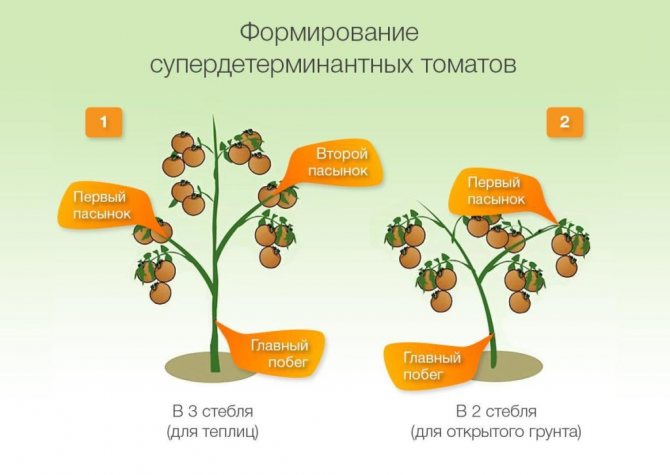

It is permissible to leave 3-5 shoots for low-growing varieties, each of them should not grow more than 2-3 brushes. With a higher load, the bush grows slowly and bears less fruit, the fruits will grow small.
How to pinch tomatoes correctly
The need for pinching tomatoes will be largely determined by their variety. A pruning procedure is mandatory for tall tomatoes.As for the removal of stepchildren on undersized vegetables, here gardeners disagree.
Low-growing varieties
Not all varieties of undersized tomatoes should be pinned. There are a number of crops that have been specifically created to grow on balconies, such as Florida and Balcony Miracle. Usually low-growing tomatoes are pruned in order to obtain more massive fruits and accelerate the process of their ripening.
Important! It is forbidden to prune shoots in wet weather, immediately after rain or wetting the bush, since there is a high probability of tomato infection with late blight.
Such varieties form 2-3 stems. If you leave only one main stem on the bush, then the harvest will be early, but not very rich. And if you refuse from pinching altogether, then the tomatoes will grow small and will ripen for a long time.
Tall varieties
As for tall plants, they must be pinned without fail. According to their natural properties, such varieties have a rather long ripening period, and if we neglect pinching, then we can expect to get ripe fruits only by winter.
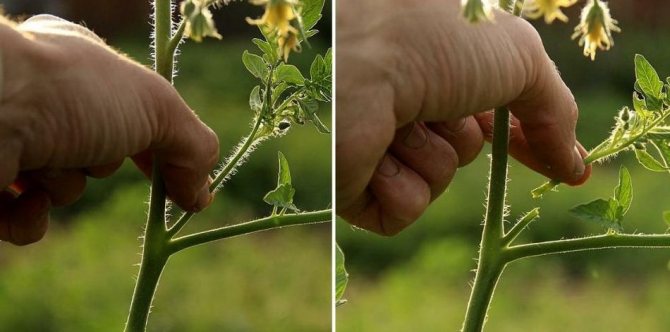

To get a good harvest in a short time, it is recommended to prune the shoots every week, while leaving one stem on the bush. If the variety assumes the presence of medium-sized fruits, then two branches are allowed.
Important! The colder the climate where the tomatoes are grown, the fewer stepchildren should be left on the plant.
Which way to choose depending on the variety of tomato
All tomatoes are subdivided into 3 varieties - determinant, semi-determinant and indeterminate. Varieties of the determinant species finish development after the formation of 4-5 inflorescences. Semi-determinants can stop growing at any time, or they can grow further. Indeterminate tomatoes grow without restrictions.
Indeterminate
They are grown in 1 stem, sometimes gardeners grow them with 2 shoots to increase the yield. Formation in 2 stems is used only in large-volume greenhouses, it is permissible to plant seedlings in them at large intervals so that the plants have enough light. The second shoot is grown from the stepson appearing under the first inflorescence, 4-5 inflorescences are left on it, the rest are cut off.
Semi-determinant
It is impossible to know in advance whether the tomatoes of these varieties will grow after several brushes. For this reason, one more (spare) escape is always left on them. If the main one stops developing, then fruits will be formed on the reserve one. If, after 6-8 brushes, the main shoot develops further, then the second shoot can be cut off so that nutrients are not consumed on it. The strongest stepson should be left as a reserve stem.


If plants of a certain variety can grow above the greenhouse, then one shoot is left on it. The tip is pinched a month before harvesting.
See also Description and characteristics of the Alsou tomato variety
Superdeterminant
For such varieties, the previously described schemes cannot be used, but their development cannot be "left to chance". It is necessary to regularly tear off the leaves located under the lower brush. This will reduce the load and the crop will ripen faster. Superdeterminate tomatoes form 1-2 stems.
No more than 3 brushes are grown on each stem. If you still leave 3 shoots, then you will receive a part of the unripe fruit. Ripening occurs simultaneously and the plant does not have enough strength.
Determinant
Some determinant low varieties do not form at all. But in order to grow many early fruits, the bush needs to be grown in only 1 stem. No more than 4 inflorescences are left on it, the rest are cut off during the removal of the stepsons. Above the last brush, a few leaves are not touched, and the growth point is pinned.With this formation, you can get the harvest 2 weeks earlier. Tips for growing determinate tomatoes are on the seed package.
When it is necessary to carry out pinching
It is important not only to pinch the tomatoes, but also to do it at the right time. Experts recommend starting pruning of stepchildren while planting seedlings. In tomato seedlings of indeterminate type, lateral ovaries are already clearly identified, which makes them easy to remove. When 5 to 7 ovaries are formed on the stem, depending on the variety of tomatoes, the massive growth of stepchildren begins. From this moment on, it is necessary to carry out pinching regularly, every week.
Important! The stepchildren will have to be removed from the plant constantly, until harvesting. If tomatoes are grown in a greenhouse, then pinching continues after harvesting.
In addition to lateral processes, in indeterminate plants, you need to remove the lower leaves and pinch the top of the main stem. It is best to prune the side shoots when they are still small (maximum 8-10 cm in length). Otherwise, an infection can get into the cut site, which can lead to the death of the bush.
Care after the procedure
Special care for tomatoes after pinching is not required.
Only a few common operations need to be performed:
- Watering. The best frequency is 1-2 times in 7 days, heated with water, you need to moisten the soil by pouring it only at the root. It is impossible to overmoisten the soil - after that, stepchildren will begin to actively grow.
- Garter shoots.
- Removal of damaged and diseased leaves.
- Weed removal.
- Loosening is carried out after watering, if necessary, soil is poured under the stem.
- When planting seedlings in the wells, nitrogen fertilizers are added. Subsequently, this element is not required for tomatoes, on the contrary - its surplus provokes increased growth of new shoots. For tomato, only phosphate and potash fertilizers are needed.
The pickling of tomatoes is not limited only to the removal of emerging shoots. Often, new shoots begin to grow right out of the ground, they also take away nutrients and require removal.
Finish the formation of the bush by removing the top of the shoot. This work is done at the end of the season. It is needed so that new brushes and fruits are not laid.
At the end of August, the upper part of the tomato bush is cut off - only a few leaves are left above the branches with fruits. This will stop the growth of the plant, stop the consumption of nutrients to create green mass.
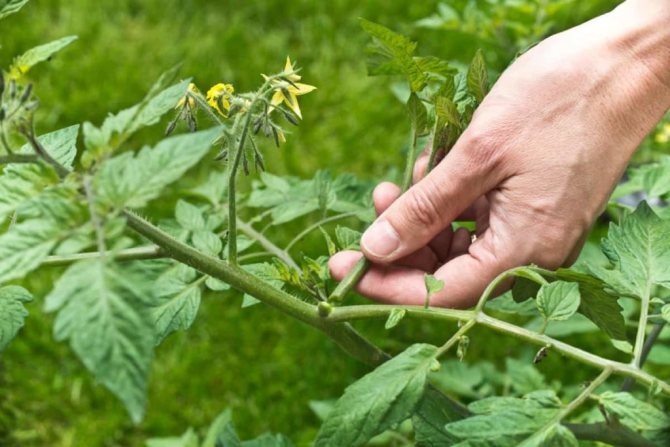

Low-growing varieties that do not need pinching


To facilitate maintenance and save time in greenhouses, they practice the cultivation of undersized varieties that do not need pinching. They form low bushes up to 70 cm. Stepsons do not form on them at all or grow in small numbers. Such varieties have high immunity, they can withstand changes in temperature and humidity.
Low-growing varieties for greenhouse cultivation:
- Siberian pirouette produces elongated fruits suitable for canning;
- Oak belongs to the ultra-early varieties with round, fleshy fruits;
- Countryman - an early variety with high yields, suitable for seedless cultivation.
Tomatoes that do not need pinching are classified as early or ultra-early. Therefore, when grown in greenhouse, they give the first harvest in early or mid-July. They form even fruits weighing from 80 to 100 g.
With timely pinching of tomatoes grown in a greenhouse, it is possible to improve their illumination and airing. Then all the strength of the plant is spent on fruit formation. This makes it possible to significantly increase the yield of the crop.
Possible difficulties when pinching greenhouse crops
Mistakes will harm and reduce crop yields. Basically, gardeners make several mistakes:
- Shoots are rarely pinched. Stepsons turn into strong shoots that consume a lot of nutrients.As a result, many small fruits grow on the tomato, which ripen for a long time;
- Instead of unnecessary stepsons, they cut off the flowering lashes. The fruit branch grows directly from the main stem. And a stepson appears from the bosom of the leaf;
- Using a dirty tool. Equipment that is not cleaned of dirt and infection can infect all tomatoes in the greenhouse. In this case, it is better to do the work by hand, or wear rubber gloves treated in a disinfectant solution.
- Excess fertilization. If the bushes are already fully formed, and stepchildren are actively appearing in the lower part of the stem, then this indicates that you are overfeeding the tomatoes. It will take a while to abandon feeding or change their composition.
Passing tomatoes growing in greenhouse conditions after a certain period of time, the gardener facilitates the movement of fresh air between the leaves, improves the illumination of the plants, and additionally directs all the forces of the plant to the development and ripening of fruits. This will give you a lot of large tomatoes.
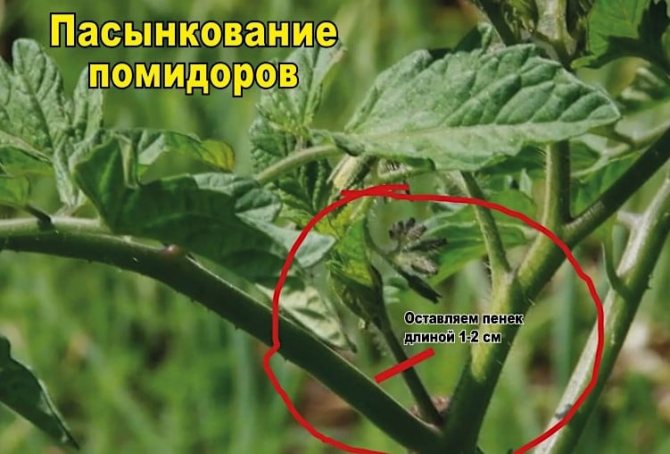

Possible mistakes
Sometimes novice gardeners are too lazy to pinch the bushes regularly. Then you have to remove a large number of processes at one time. As a result of this procedure, the plant spends a lot of energy on recovery. In addition, with this approach, most of the nutrients are spent on the growth of green mass, and not on the formation of ovaries.
Another mistake is to remove the fruit shoots instead of the stepsons. A fruiting branch is a process that extends from the stem with formed inflorescences.
Do not use dirty tools to remove the appendages. Before and after work, pruning shears, a knife or other tool are disinfected with a chlorhexidine solution, alcohol, potassium permanganate or bleach.
Advice! in order not to waste time on disinfecting the instrument, you can cut off the stepsons with your hands.
Unlike other activities, pinching is best done during the daytime in sunny weather. In dampness and lack of sun, the wounds on the plant heal slowly. This increases the likelihood of contracting viral or infectious diseases.
What will happen if you do not pinch in the open field or greenhouse
Sometimes gardeners ask themselves: what will happen if the pinching process is not carried out. The answer is obvious:
- there will be a lot of greenery, but little fruit;
- tomatoes grow small and do not have time to ripen on the branches;
- it is not convenient to harvest;
- the appearance of pests;
- spread of fungal infection to the fetus;
- acute lack of trace elements throughout the plant.
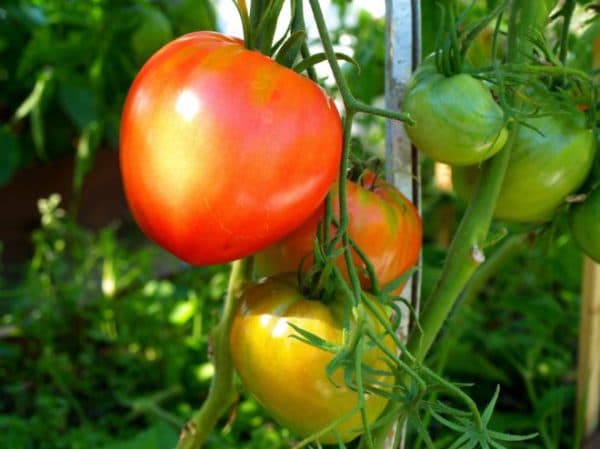

If the tomatoes are not pinched, then the fruits will not have time to ripen on the branches.
If the main goal is the highest yield from a bush, then three stems can be left as much as possible, while not disrupting the air exchange in the room and the correct ingress of sunlight.
Rules and technology
To achieve the desired result, you must surely know how to properly pick off stepchildren from tomatoes. Shoots grow from the corner of the leaf, so it is very important to distinguish them from the main stem. Moreover, the earlier you start such a procedure, the easier it will be to carry out. It is not so easy to eliminate the hardened sprouts without harming the plant. If you take up the formation of seedlings at the right time and follow the basic recommendations of specialists, you will get the desired result, and your tomatoes will develop to the fullest.


Follow the procedure step by step, based on the following rules:
- if the process that you are going to cut is no more than 5–6 cm in length, you can safely remove it;
- removing excess shoots will not cause any harm to the plant if the procedure is carried out in the morning. It is also advisable to choose a day on which precipitation is not expected;
- a certain pruning sequence must be followed.First of all, excess shoots are removed from healthy bushes and last but not least from sick ones (if there are any on your site);
- the shoots that you cut off, in no case, do not try to leave near the tomato bushes. In the future, it is they who can become a breeding ground for pathogenic bacteria and viruses, and pests primarily attack these parts of the plant.
Knowing how to properly remove stepchildren from tomatoes, you will be able to form the growth of shrubs properly.
How is the pinning carried out
The stepson is most often broken off by hand - the stalk is clamped between two fingers - the index and thumb. Begin to swing slightly from side to side until the process comes off the sinus. Broken off pieces are put in a bucket and taken out of the site.
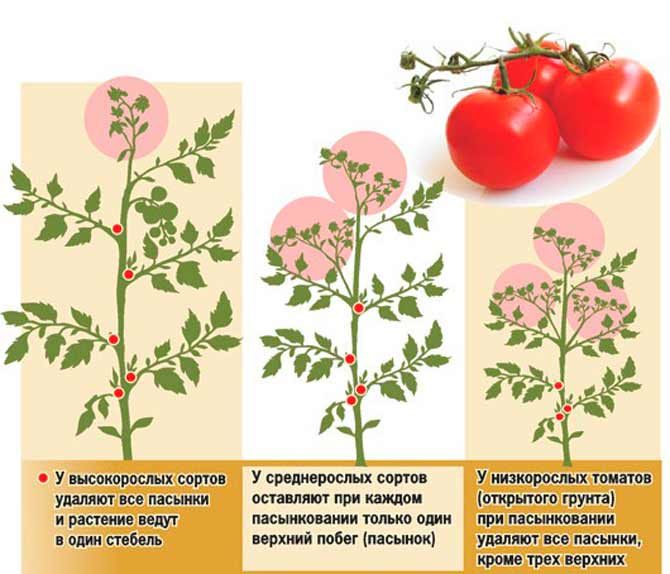

When using a knife or garden shears, they are sharpened to a razor sharp point. Cutting movements are performed quickly and as accurately as possible so as not to touch other parts of the tomatoes. When moving from one bush to another, the tool is disinfected:
- In 1% potassium permanganate;
- In 1% bleach.
Popular: Planting plants in 2020 according to the lunar sowing calendar
Sometimes a new shoot grows in the place of the removed stepson, despite the stump left. Growth comes from a dormant bud. This happens when there is an excess of food or because of varietal characteristics. A young shoot is broken off or cut off.


